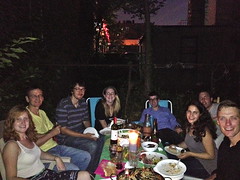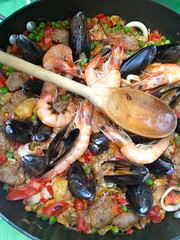Villafranca del Bierzo
We walked into town along the Calle del Agua, which provides excellent examples of what the town’s website refers to as typical medieval architecture. The street is lined with old palaces and the occasional convent, many of them bearing family or institutional crests and heraldry.
We checked into our albergue, which put us all in a large upstairs room with lots of light and lots of bunk beds, as has become almost normal. Snoring has also become part of the regular routine, though some people have adapted better than others.
We met in the afternoon outside the Church of Santiago in a light rain, which brought out our varied assortment of rain gear for its first major use.
The church of Samtiago dates to 1186 and is on the pilgrim’s route into town — it is one of the first buildings you see as you walk towards Villafranca. The most notable feature of the church is the Porto del Pardon, where medieval pilgrims too sick or feeble to continue the full distance to Santiago could receive a pardon. Villafranca was the only place along the Camino Frances where this pardon was granted, and it sometimes calls itself the little Santiago as a result.
The iconography of the Door of Pardon is a bit confused, as the door appears to have been altered several times, as has the church itself. The keystone of the arch is unclear and the blocks of the portal are disarranged. The different stages of construction and reconstruction are visible in the bands of different kinds of stonework, much like what we saw at the Templar Castle.
From the Church of Santiago we walked over to the Castillo of the Marquises of Villafranca, an impressive square castle with four towers and a large courtyard. We were unable to visit it, since it is currently a private home, but we were able to see from other points in town that the courtyard appeared to be overgrown, and some of the walls in less than perfect condition. This is the result of a serious fire, after which not all of the Castillo was restored.
By this point the rain had more or less let up, which was a welcome relief.
The highlight of the tour, at least for those who like architecture, was the visit to the church of San Francisco, a 13th century building that is all that remains of the former convent of San Francisco. We were particularly lucky this year and were able not only to see the outside of it but to also be allowed in. The main claim to fame of the church is its coffered ceiling, which is Mudejar work, and whose geometric patterns are almost mosque-like. The contrast between the ceiling and the Baroque altars was an interesting one, and an example of the ways in which different time periods and different styles so often overlap or exist side by side along the Camino.
We proceeded along the Calle de Agua again on our way back to the hostel, and Dr. Gyug showed us an alley that is tiled with plaques of poetry to the city of Villafranca interspersed with terra-cotta figures.
In the evening, we went grocery shopping, and several people cooked dinner for the group, which was a welcome break from restaurants.
I’m told the day closed with more snoring, but since it rarely wakes me up, I couldn’t say.
Alisa Beer
P.S. — There will be photographs as soon as I find the cable for my camera. But it may be in New York.











Recent Comments